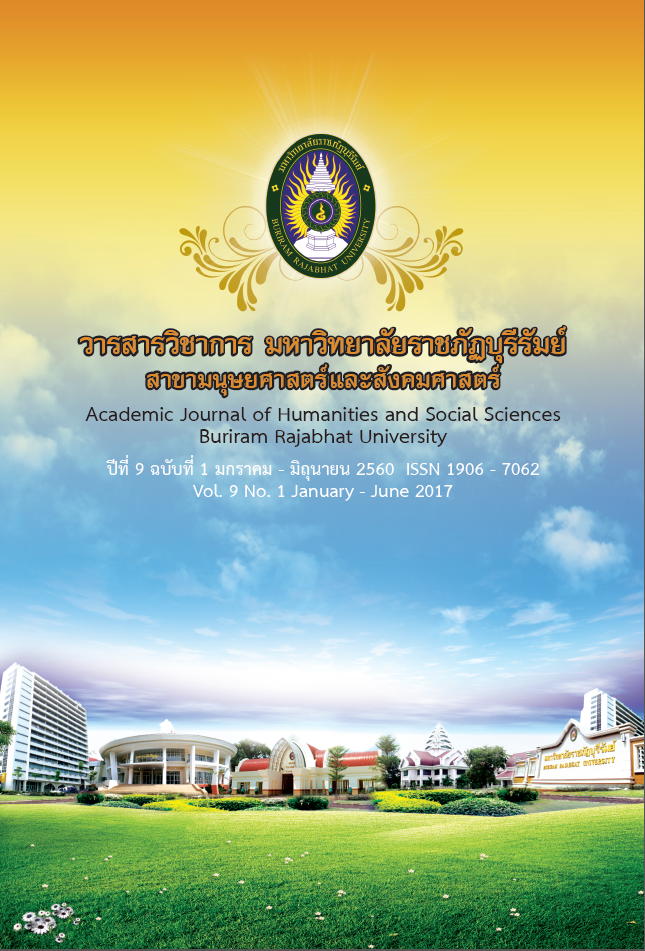การพัฒนาความสามารถในการเขียนอธิบายเรื่องเป็นลำดับขั้นด้วยรูปแบบการสอน ที่เน้นงานปฏิบัติ ตามรูปแบบของวิลลิส สำหรับนักเรียนชั้นมัธยมศึกษาปีที่ 2
Main Article Content
บทคัดย่อ
การศึกษาครั้งนี้มีจุดมุ่งหมายเพื่อศึกษาความสามารถในการเขียนอธิบายเรื่องเป็นลำดับขั้น
ของนักเรียนที่ได้รับการจัดการเรียนรู้แบบเน้นงานปฏิบัติ ตามรูปแบบของวิลลิส กลุ่มตัวอย่างเป็น
นักเรียนชั้นมัธยมศึกษาปีที่ 2 โรงเรียนเมยวดีพิทยาคม จังหวัดร้อยเอ็ด ภาคเรียนที่ 1 ปีการศึกษา
2558 ที่ลงทะเบียนเรียนวิชาภาษาอังกฤษ อ 22101 จำนวน 5 ห้องเรียน รวมทั้งสิ้น 152 คน ซึ่งได้
รับการจัดแบ่งห้องเรียนโดยคละความสามารถ จำนวน 1 ห้องเรียน รวมทั้งสิ้น 30 คน ได้มาโดยวิธี
การสุ่มอย่างง่าย (Simple Random Sampling) เครื่องมือที่ใช้ คือ แผนการสอนเขียนแบบเน้นงาน
ปฏิบัติ จำนวน 6 แผน แบบทดสอบวัดความสามารถด้านการเขียนอธิบายเรื่องเป็นลำดับขั้นและแบบ
วัดเจตคติที่มีการเขียนอธิบายเรื่องเป็นลำดับขั้นโดยทำการทดสอบก่อนเรียนและหลังเรียนด้วยแบบ
ทดสอบวัดความสามารถในการเขียนภาษาอังกฤษและตรวจ
การวิเคราะห์ข้อมูล ใช้ค่าเฉลี่ยของคะแนน ค่าร้อยละ ค่าเบี่ยงเบนมาตรฐาน ความแตกต่าง
ระหว่างค่าเฉลี่ยคะแนนโดยใช้สถิติ t – test แบบ Dependent Samples
ผลการวิจัย สรุปได้ดังนี้
1. นักเรียนมีความสามารถด้านการเขียนอธิบายเรื่องเป็นลำดับขั้น โดยการจัดการเรียนรู้แบบ
เน้นงานปฏิบัติสูงขึ้นกว่าก่อนเรียนอย่างมีนัยสำคัญทางสถิติที่ระดับ .05
2. นักเรียนมีเจตคติต่อการเขียนอธิบายเรื่องเป็นลำดับขั้น โดยการจัดการเรียนรู้แบบเน้นงาน
ปฏิบัติสูงขึ้นกว่าก่อนเรียนในระดับพึงพอใจมาก
ผลการวิจัยชี้ให้เห็นว่าผลการเรียนรู้ด้านการเขียนอธิบายเรื่องเป็นลำดับขั้นของนักเรียนที่ได้
รับการจัดการเรียนรู้แบบเน้นงานปฏิบัติ ตามรูปแบบของวิลลิส ของนักเรียนชั้นมัธยมศึกษาปีที่ 2
ส่งผลให้การเขียนภาษาอังกฤษของนักเรียนดีขึ้น และนักเรียนมีเจตคติต่อการเรียนภาษาอังกฤษสูงขึ้น
อีกด้วย สามารถนำไปใช้ในการเรียนการสอนเพื่อให้ผู้เรียนบรรลุจุดประสงค์ได้
The purpose of this study was to investigate the students’ sequential writing
ability through Willis’ Task based Learning Framework. The sample group were 152
Mattayomsuksa 2 students in the 1st semester of the academic year 2015 who
registered English subject (E 22101). The researchers chose 30 Mattayomsuksa 2
students, selected by simple random sampling technique from one of five classes.
The instrument consisted of six tasked – based learning lesson plans, sequential
writing tests, sequential writing rubric, and a questionnaire on students’ attitude towards
sequential writing. Data was collected by using pre-post sequential writing tests,
following with six lesson plans. The researchers scored student tests by using sequential
writing rubric. The data were statistically analyzed using mean scores, percentage,
standard deviation, and t-test for dependent sample.
The study revealed the following findings:
1. Students’ abilities in sequential writing after taking sequential writing class
was significantly higher than before taking the class (p< .05.).
2. The students’ attitude towards expository sequential writing class was at a
significantly high level. (p< .05)
The results indicated that expository sequential writing through Willis’ Task
– based Learning Framework significantly enhanced students’ writing abilities and
improve their attitudes towards writing in English. Moreover, this teaching model
was appropriate to enhance students’ writing abilities. Finally, the sequential writing
instruction method in the present study has been enhanced to be an effective
technique for EFL writing instruction.
Article Details
- ต้นฉบับที่ได้รับการตีพิมพ์ในวารสารวิชาการ มหาวิทยาลัยราชภัฏบุรีรัมย์ สาขามนุษยศาสตร์และสังคมศาสตร์ ถือเป็นกรรมสิทธิ์ของมหาวิทยาลัยราชภัฏบุรีรัมย์ ห้ามนำข้อความทั้งหมดหรือบางส่วนไปพิมพ์ซ้ำเว้นเสียแต่ว่าจะได้รับอนุญาตจากมหาวิทยาลัยฯ เป็นลายลักษณ์อักษร
- เนื้อหาต้นฉบับที่ปรากฏในวารสารเป็นความรับผิดชอบของผู้เขียน ทั้งนี้ไม่รวมความผิดพลาด อันเกิดจากเทคนิคการพิมพ์


